The Sun Temple at Konark is the pinnacle of architectural perfection as a chariot of the Sun God.
Konark Temple – Chariot of the Sun God
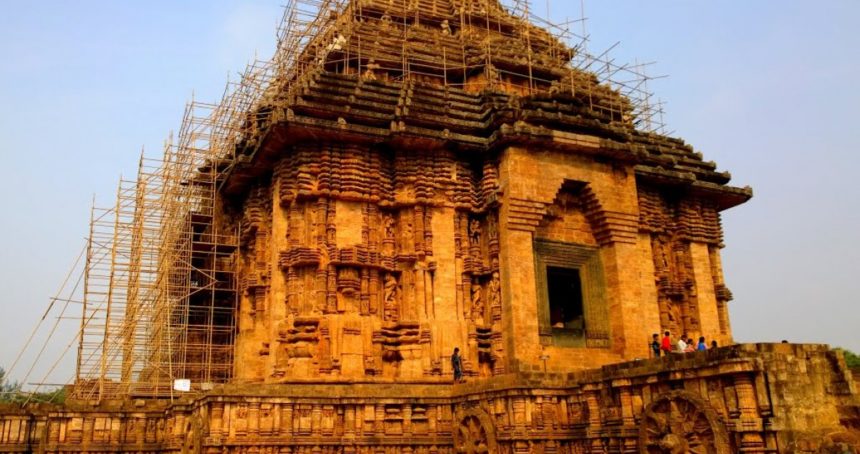
Introduction
Konark, a coastal town in Odisha, is part of a dream triangle for tourists with Bhubaneshwar (65 km) and Puri (35 km) being the other two nodes. Konark is the site that beholds the most extraordinary Chariot of the Sun God – The Konark Temple, a UNESCO World Heritage site. It was built in the 13th century by King Narasimhadeva of the Eastern Ganga Dynasty. This temple is dedicated to Surya (The Sun God), who is the source of life-giving energy, the ultimate healer of diseases and the fulfiller of desires. This temple is designed to represent Surya in the manner represented in iconography since the Vedic era. The main structure is in the shape of a colossal chariot that carries the Sun God. There are seven horses that pull the Chariot and twelve pairs of wheels that are sculpted around the massive structure. The main entrance faces the East, the direction of the rising Sun. It was designed in typical Kalinga Architectural style – The ‘deul’ (Rekha/Bada deul) or main sanctuary was built on a high terrace where the main deity was hosted. In front of it was the Bhandra deul or Jagmohan (small sanctuary) where the public gathered. On the eastern side of the main temple is the ‘Natya Mandir’ (dance temple). There were other smaller shrines around the main structure.
The representation below gives an understanding of what remains of the main majestic structure. The remains of the main Shikhar is tragically only rubbles now. The Chariot and the Natya Mandapam exist as a reminder of the pinnacle of stone architecture and sculpting abilities along with the majestic scale of temple construction from an era long gone. The fantastical stone carvings and presentations of eroticism, royal processions and warfare, guru sermons, simple daily chores, travellers from foreign lands, animals and plants, numerous dance steps, deities and so much more leave the viewer mystified and spellbound.
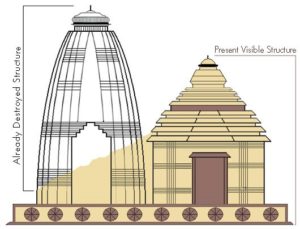
Legends of Konark
Konark has been associated with Sun worship since Puranic times. Lord Krishna’s son Samba did penance to cure his leprosy near the confluence of Chandrabhaga River and the sea at Konark. He succeeded in getting a boon from the ultimate healer, the Sun God and was cured of his illness. An alternative story mentions that after killing the Demon Gayasur, Lord Vishnu placed his lotus at Konark.
Story of the Temple
Although the temple is definitely dated to around 1250 CE, it is very difficult to get an accurate historical record of its exact construction details or how it was destroyed. A timeline of less than 800 years doesn’t even qualify for the ancient tag in Indian history, but the destruction of cultural heritage has been so devastating and brutal that all history relating to its construction methods and the various attacks on it only remains in local memory.
The main deity of the temple was the Sun God and the Idol had magnetic properties. The top of the Shikhar was an enormous lodestone acting as a powerful magnet. The walls of the main tower (Shikhar) had metal plates sandwiched between stones. The magnetic arrangements were such that the main deity floated in the air without any support from any side. The early morning sun rays crossed the Natya mandapam and Jagmohan and sunlight was reflected from the diamond placed at the crown of the deity. The temple was also known as the Black Pagoda by the early Europeans. Its enormous magnet is supposed to have interfered with the compass of the ships sailing on the coastal route, as the temple was nearer to the sea than it is today.
Regarding the destruction of the temple, the most consistent story is about a barbarian chieftain called Kala Pahar, who destroyed the main tower and vandalised the exquisite carvings. The narrative is consistent with the dastardly behaviour of looters and vandals throughout this tumultuous period of the history of India.
What we see today are the partially reconstructed remains of the Konark Sun Temple. The full structure is available only in reconstructed drawings with no certainty about when the main Shikhar was destroyed.
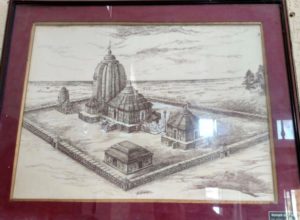
[An impression of the original construction]
The Natya Mandapam
As one enters the temple complex, one is greeted by the presence of two huge lions shown to be subduing elephants with humans below them. The stairs in-between these ferocious lions leads to the remains of the Dancing Hall. The hall stands on a high, intricately carved platform that has numerous pillars. The upper structure is no more except for some pillars that are intricately carved. Not an inch can be found without any carving as miniature carvings and filigree fill the gaps.
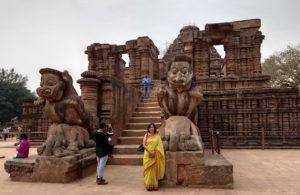
[Entry to the Natya Mandapam]
All around the platform there are three parallel layers of carvings of danseurs in varied dance poses along with beautiful ladies playing musical instruments as if giving the beats and the atmosphere for the dancers to continue with the divine dance and enrapture all in its rhythm. The entire structure is replete with intricate carvings.
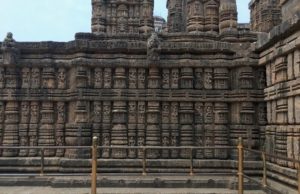
[Exquisite carvings of dance poses on the sides of Natya mandapam]
There was an Aruna stambh (Pillar) that stood between the Natya Mandir and the main Temple. This was removed so as to save it from destruction during the troubled phase of this temple. It was placed in front of Jagannath Temple at Puri. It stands today at Puri as a reminder of the efforts taken by the devotees to save whatever they could from the destructive hands of the invaders.
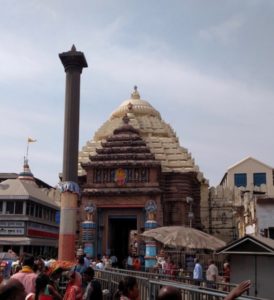
[Pillar in front of the Jagannath Puri temple]
The most intriguing part of the remains of the majestic temple is the Chariot depicting the Sun God riding on his chariot, pulled by his seven horses that take him on his daily journey across the skies. These horses have also been extensively damaged. Two pairs of wheels are on this extended portion of the chariot. The other ten pairs are carved on the base of the Jagmohana.
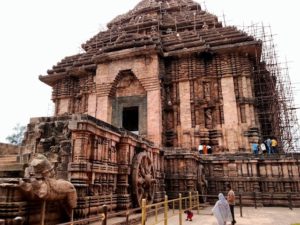
[The main structure in the form of Ratha or Chariot]
The main structure of the Jagmohana is massive with a height of 100 feet. The architectural design is such that it is divided into six stages with the first two forming the square structure above the base. Thereafter the other tiers diminish in width to form a tapering Vimana with a Shikhar on the top. The main entrance faces the East and its lintel is carved out of a greenish coloured stone called chlorite. Huge Human figures and mystical creatures are carved onto the first few square tiers. Extensive reconstruction has been done to keep the structure stable.
This temple chariot consists of 24 wheels carved along the northern and southern walls. Each wheel has a diameter of 9 feet and 9 inches and eight main spokes along with eight minor spokes. These wheels had the practical purpose of functioning as sundials. The circular centre and the main spokes have carvings of exceptional quality that depict deities, dancers, animals and much more. No two spokes have identical presentations. Different wheels have different themes for these carvings within the wheels and the legend says that they represent different seasons to match 12 months in a year. The area within the circumference of the wheel has layers of filigree style of carving. The human mind stays baffled at the exceptional quality of this intricate work.
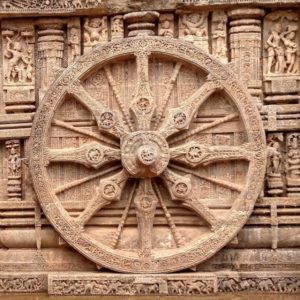
[One of the iconic wheels]
The walls of the structure containing the Jagmohan and the sanctum sanctorum area have multiple layers of carving all around the temple. The lowest level of carving at the base is approximately eight inches high and runs around the entire structure. These carvings are mostly of animals, predominately the elephant. Elephants in various activities amidst the foliage, war elephants, baby elephants, etc. Above the base are semi pillar depictions with a lotus base and floral motifs run along this level. Above this are two prominent levels of carvings containing depictions of Beautiful ladies, Nagas (half-snake and half-human), deities, erotic postures that reveal the Kamasutra on stone, royal and festive processions, palanquins, foreigners, mystical and rare animals, steps of beautification or Shringar, and more. Between these two layers, there is a continuous series of floral motifs and exquisite filigree work. There are smaller panels with carvings of erotic images and other day to day life events along with these bigger panels. It is as if a three-dimensional book revealing the happenings of those times have been created for generations to see and understand contemporary life.
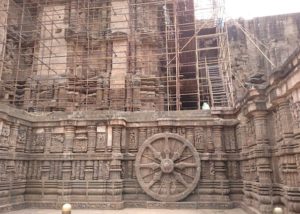
[Carvings all around the Jagmohan base]
There are some carvings that reveal the awareness of the people of those times. A Giraffe along with people/traders are seen interacting with men on an Elephant. The Giraffe is an animal indigenous to Africa and is not found in the Indian Subcontinent. This image reflects the foreign interactions of this kingdom.
The image of Nagas is very common all around the temple. They are depicted as a deity and also in coupling postures. The Naga theme is ubiquitous in ancient sculptures and carvings all across India.
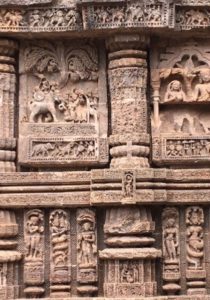
[Panel showing a Giraffe facing an Elephant]
Some areas of carving depict details of daily activities. In the panel below we see a mother taking care of her children, an elephant and its caretakers, a horse being led by a soldier that is followed by a ladies procession along with a palanquin and chhatris (umbrellas).
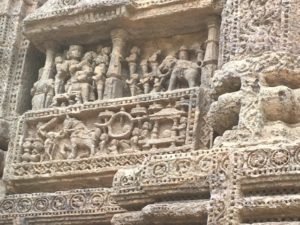
[Daily activities carved in stone]
The top-level carvings on the panel of this huge raised platform depict minute details of contemporary life, warfare and processions. Here we see manned elephants, flagbearers, men and women carrying various utility-based articles, palanquins of varied kinds, chhatris or umbrellas, load bearers, horses etc. It is unimaginable how much effort would have been needed to actually carve out these remarkable details within this miniaturised panel.
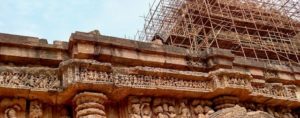
[Miniaturised Panel]
Maiden doing Shringar (beautification) is seen on various panels. The panel below is a favourite of every guide and it is of such a small scale that the visitor always overlooks its significance unless specifically pointed towards this image. Here we see a maiden looking into a mirror as she adorns herself. Two helpers stand near her. One carries a vanity bag or a purse that is quite similar to the ones we see ladies carrying to this day.
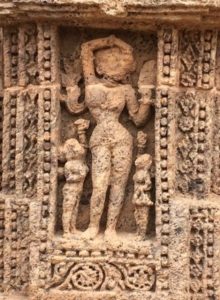
Health tips or practices of those days have also been depicted in some panels. An intriguing depiction is of a woman standing with her legs apart above a small fire. It is said that after childbirth, the herbal antiseptic smoke helped to prevent infections. Our ancients were well aware of the importance of good health and how to stay fit.
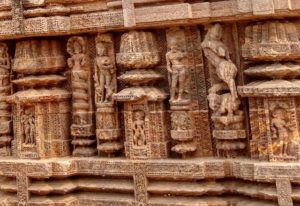
The walls of the Jagmohan and the area of the main Shikhar contain many erotic sculptures. It shows the maturity of the civilisation where these carvings were placed side by side with the other ceremonial and mundane day to day activities. The profile of visitors today shows the same open-mindedness, where whole families with kids and aged members of the family nonchalantly admires the artistry without having any odd feeling due to the adult theme of these erotic images.
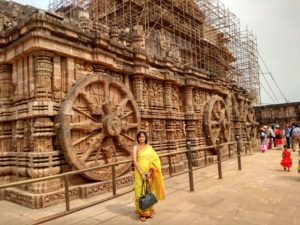
The view from the West side of the temple structure reveals the remnants of the massive Shikhar that was the sanctum sanctorum for the Sun God. This view has a daunting effect. It leaves one imaging the enormous impressive structure that would have been present if the invaders did not destroy such beautiful structures.
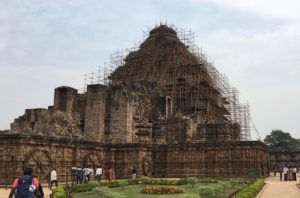
[Remains of the Shikhar]
There are 3 sculptures of Sun God on the Northern, western and southern side of the temple. These are barely visible from the ground as it is on the raised level surrounded by the rubble. Other major deities – Durga, Vishnu and Shiva also find a place here. Some of these sculptures have been removed and relocated to museums far and wide. Capturing images of the Sun God sculptures is a difficult task. The height and distance from the ground plus the reconstruction efforts all around the structure does not allow a direct view of the deity.
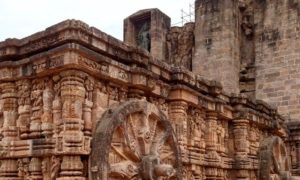
[Surya statues above the platform on the west side]
These sculptures have many images within their enclosures depicting themes from Indian mythology. The northern side image shows the setting Sun when even the horse is tired and it is depicted with folded legs. There are various celestial beings carved all around the main deity.
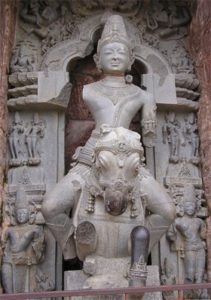
Conclusion
The scale of the construction and magnificence of the carvings on stone cannot be adequately captured in words. In its original undamaged form, it must have been a source of awe and inspiration for all visitors. When Erich Von Daniken wrote in his seminal book in the 1960s about his theory of the likelihood of aliens visiting us in ancient times, he named his book “Chariots of the Gods”. It is not known whether he had any idea of this wonderful stone monument constructed literally as the Chariot of the God. Even in this damaged state, it is of such magnificence that it retains a proud place among the numerous grand structures of the world as a UNESCO World Heritage monument.

Leave a Reply